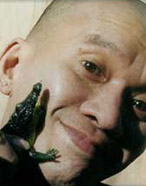 |
||
|---|---|---|
| CP Foundation | About CP Biennale | 2003 | 2005 | Contact Us | >||
           
|
||
|
The camera as the most valid recorder of reality becomes a "subject" for Agus Suwage, in the sense a "subject" that sees him - he sees himself from the outside. However Suwage realizes that photograph of him resulting from the mechanics of the camera is not entirely "real" - rather they are images of his physical being that do not reflect his mental condition. Here, photographs of him function as a "mirror", forming a dialectical space for him to interact with his surrounding reality. Representations in Agus Suwage's works no longer deal with production of meanings. The representations tend only to signify realities. Within this signifying process the signifying field of the "I" is perpetually undergoing reconfiguration. It is then not relevant anymore to consider the autonomy of the relationship between concept and reality. The relationship has become highly unstable and influenced by other signifying fields. Even the relationship between the self and the self-identification is only temporary. The question "who am I" raised in Suwage's paintings is a small window to seek meanings in reality. The question "Who am I" is located in a spiritual space that functions as an "emergency door" to set the individual free from the beleaguered condition. In this spiritual space, sensibility interacts with personal experiences and enables sublimation to take place. Such sublimation does not turn the pain into beauty, but changes the pain into a statement of pain that reduces its terrorized experience. In Suwage's paintings, realistic images are not at all realistic portrayal. They are retouched photographs. Brush-strokes that look expressive in his painting do not represent emotional expression. They are merely paint in a concrete sense. Using those two texts he creates puzzling images. Viewer cannot identify these images because it is difficult to conclude whether the images represent realities or just paint. Images that show effects of torture on his body in his self-portrait do not look like sadistic pictures because viewer immediately sees them as just paint. An open scar on the flesh in his painting, for example, does not terrify viewer since it looks like a red paint. Jim Supangkat, Aminuddin TH Siregar Born on 1959 in Purworejo, Central Java, Indonesia. SELECTED SOLO EXHIBITIONS SELECTED GROUP EXHIBITIONS |
||
|
CP Foundation | About CP Biennale | 2003 | 2005 | Contact Us
Jl. Suryopranoto 67A, Jakarta 10160, Indonesia. ph. +62.21.3448126, 3853206 | fax. +62.21.3853203, 3853208 info@cp-foundation.org |
||
 In his latest development Agus Suwage tend to exploit his body to search media and techniques to communicate his thoughts. Since mid 1990s, his own portraits have become dominant in almost all of his paintings and drawings. His self-portraits on canvases that use various techniques intentionally mimicking photography. Agus Suwage indeed uses camera to create his self-portraits.
In his latest development Agus Suwage tend to exploit his body to search media and techniques to communicate his thoughts. Since mid 1990s, his own portraits have become dominant in almost all of his paintings and drawings. His self-portraits on canvases that use various techniques intentionally mimicking photography. Agus Suwage indeed uses camera to create his self-portraits.